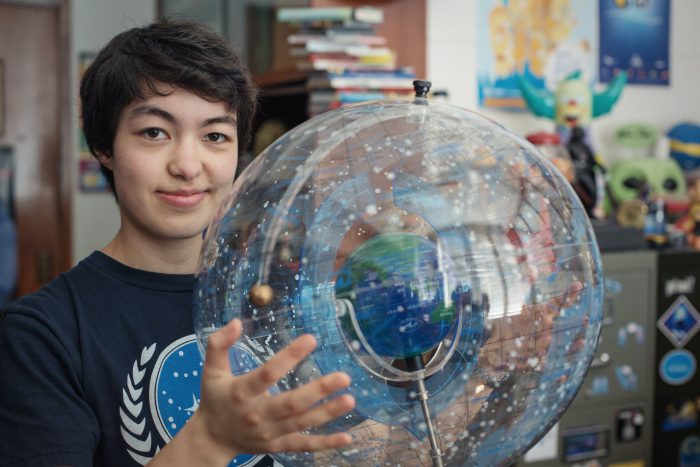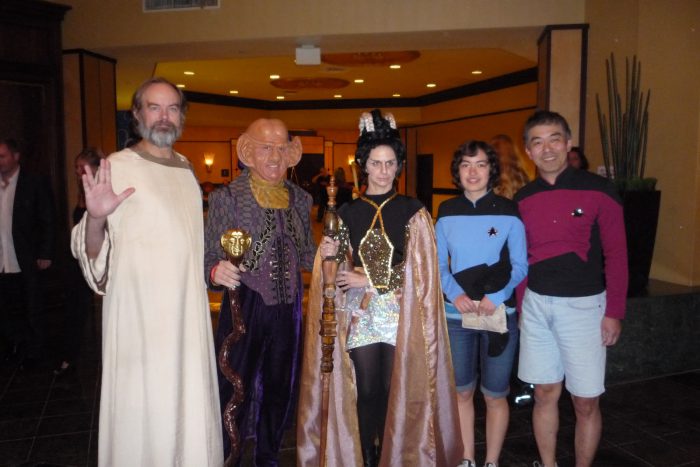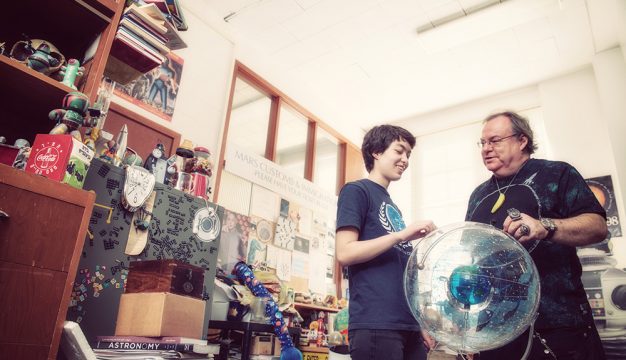When you think of the coolest job in the world, what comes to mind?
Video game tester? Pro athlete? Candy critic?
All excellent choices. But how about ...
Planet hunter?
Pretty cool, right? But is it real? Yes, it is!
Just ask 28-year-old Michelle Kunimoto from BC, Canada. Michelle currently works for the TESS mission, an operation dedicated to finding exoplanets, a.k.a. planets outside our solar system.
This NASA mission based out of MIT (Massachusetts Institute of Technology) analyzes data from TESS, or Transiting Exoplanet Survey Satellite. In her young career, Michelle has discovered dozens of planets, while working as part of a group that has found thousands more!
From the backyard to the front of the line

Picture of a planet hunter. (Martin Dee)
But like so many of us, she started out as a normal kid with interest and dreams. In her case, staring up at the night sky and wondering what was up there. Then a gift and a classic TV show combined forces to change her life. How?
Let Michelle tell her amazing story right now!
OWLconnected: What was science like for you when you were in grade school?
Michelle Kunimoto: I definitely recognized that I was really interested in science classes in elementary school. But it wasn't until late high school that I really started to think that I should/might do physics and astronomy. As a kid, I thought science was just really, really cool. I read a lot of OWL magazines when I was growing up in the Fraser Valley in BC.
OC: Yay! Thanks for reading.
MK: So I never really thought, “Wow, this could be something that I do for a career!” I just remember reading a lot of the stories and science really fascinated me.
OC: So what changed in high school to make science a bigger part of your future?
MK: In Grade 9, a couple of things happened. First, in the BC science curriculum we started learning about astronomy. Planets, galaxies, stars, all that stuff. I had this great physics teacher—he was a really great educator and probably my favourite teacher.
This was also the year that my dad started showing my brother and I the original series of Star Trek. It was a show that was very cheesy in a way, but it was also just so ahead of its time. And I really loved how they were exploring, seeking out new life, looking at new planets, talking about potentially habitable planets, looking for and talking to aliens. (laughs) It just really captured my imagination!
And a third thing that happened in that year is I inherited a telescope from my great uncle. Nobody really knew what to do with this telescope that he used for bird watching. And I was like, “Well, I'm kind of getting interested in this. I'm really enjoying my astronomy classes. I really love Star Trek … maybe I’d be able to take the telescope?”

Michelle and her father (right) attending a Star Trek convention together. (Courtesy of Michelle Kunimoto)
OC: That’s an amazing thing to inherit.
MK: Yeah! So I took it out at nighttime for the first time and just tried to find the solar system objects. And I was able to pick out Jupiter and Saturn—you could even see Saturn’s rings and some of the atmospheric lines on Jupiter! And I was like, “Oh my gosh! I'm actually seeing other planets with my own eyes. And they're not just tiny specks—I actually see detail and they just feel so close!”
OC: So thrilling!
MK: I think it was really engaging in science like that—hands on—that helped start me on a path. Then when I was applying for university, I was deciding between engineering, physics, and music, I just kind of kept thinking back to that year in high school—when I was watching Star Trek and just really loving being surrounded by that. So I decided to put physics as my first choice!
OC: That must have been quite a powerful telescope then!
MK: It's not particularly large, but it is a very high quality telescope. Yeah. When I took it into Vancouver for repairs—because it was quite dusty and covered in fingerprints—they said, “Oh, you've just walked in with the holy grail of telescopes!” It's from the 60s or 70s, and it's just one of the best quality telescopes you can get.
OC: Cool! So you lucked out with the telescope, but how did you approach finding planets as a kid? You have to know where to look!
MK: One of the items that came with the telescope was a book—an observer's guide book. The nice thing about astronomy is the movement of these celestial objects is very predictable. We know where they are going to be 10 years from now. So even though the book was a bit old, I was still able to look up, Where will Saturn be in this year? It was just a lot of investigation.
There was also an astronomy club—the Royal Astronomical Society of Canada—at the HR McMillan Space Centre in Vancouver. I became a member there. They're always happy to provide guidance, and they also invite people like professional astronomers to come give talks about their work.
So that was also really useful for me to learn about what people can do with astronomy. Not just about taking your telescope out in your backyard and looking at the sky. There's a lot of really cool things that they do there that opened my eyes to what a career in astronomy could be like.
OC: We've written a lot about how much citizen scientists and amateur astronomers are being used by experts to help gather and examine data. That’s pretty cool, right?
MK: Definitely! Even just within the last few years, there's been a shift towards more citizen science and more encouragement for the public to get involved. There have been so many stories of high school students discovering planets!
Ten, twenty years ago, [NASA] missions would hold onto that data for years and they wouldn't let anybody other than the team itself look at it. But the mission that I'm on now is trying to get data out three days after we take it! So the public is basically getting it at the same time that we are! (laughs)

Michelle with her mentor, UBC astronomer Dr. Jaymie Matthews. “One of my role models growing up was Jaymie Matthews,” she says. “In late high school, I was at an event geared towards women in physics and engineering. He gave a presentation about exoplanets and I was just like, ‘Wow!’ So he became my thesis supervisor and my PhD supervisor in university.” (Martin Dee)
OC: So this leads into the question of: What does it mean to discover a new planet? What happens next?
MK: I can consider three important cases, or types of planets we find.
The first one is maybe the planet we found isn't particularly uncommon. We found a lot of others. It's still an important contribution. Kind of like how you can look at a population of people—at their race and ethnicity and age and education—and learn from that. We can do the same with planets as a population. Finding even ‘common’ new planets is always so important because that improves our statistics.
A second type is when the planet is really rare. Like, we've never seen a planet like this before! That can fundamentally change how we see planet formation and evolution.
One of the examples of this was in the early days of exoplanet hunting when we found a hot Jupiter. These are Jupiter-sized planets that orbit really close to their stars. So they're extremely hot and that's unlike anything we have in our own solar system where all the giant planets are far away and all the small planets are really close. We didn't even think that that was possible!
In the last few years there was the first discovery of a planet around a white dwarf (an extremely small, old star). We didn't think that was possible either. There are a lot of exotic planets that we can still discover and learn a lot about.
OC: Amazing. And third category?
MK: The third category is planets that are potentially habitable. Obviously that's touching on a question that everybody asks: Is there other life out there? What kind of planet could support life and what would that look like?
We're gradually increasing the number of planets (we know about) that are similar to the Earth in size and in temperature. That's giving us a bigger understanding of what it means for a planet to be habitable.
OC: You’ve found four planets, right?
MK: Four as an undergrad [before graduating from university]. Seventeen more as a PhD student. And I'm leading a project with the TESS mission that has so far discovered over 2,000. (laughs)
OC: Wow. Okay!
MK: And that's, that's more than 40 percent of all the planets that have been found by TESS so far. Very proud of that!
OC: So what is the average planet out there like?
MK: We believe the most common type of planet is a one that's between the size of the Earth and Neptune. So it's interesting that the solar system doesn't have a planet in that size range. Earth is the largest of the rocky planets and Neptune is the smallest of the ice/gas giants. But what we've found so far is that the most common type of planet is actually in between those two.
OC: And are those planets rocky or gas?
MK: We don't know. This is one of the biggest outstanding questions in exoplanet sciences. What is the deal with all these planets?
OC: Well, planet hunting is still quite young as a science. You entered it at the right time!
MK: The first exoplanet was discovered the year before I was born. When I was going through elementary school, there were only a few dozen that we knew about at that time. And now there's over 5,000 confirmed planets.
There have been high school students and undergrads who have discovered their own planets, too.

Michelle meeting actor William Shatner, who played Captain James T. Kirk on the original Star Trek. (Courtesy of Michelle Kunimoto)
OC: What would recommend to readers who are curious about astronomy?
MK: Inquire about if there's a local astronomy club, like the one I went to. These were monthly meetings with amateur astronomers. People from all kinds of backgrounds who are coming together with a shared interest and passion for learning about astronomy. Not super technical. And there were also kids going there to just ask questions. The amateur astronomers were always so happy to share—so easy to talk to.
OC: Any cool apps?
MK: There is a website called Planet Hunters TESS. They take all of TESS’s data, put it on the website, and then they let people from the general public look at the data themselves and see if they can spot planets.
It gives you a tutorial—requires no programming experience. I could foresee a elementary school kid doing this with a parent. They'd be able to actually contribute to the discovery of planets! People on this site have found hundreds of planet candidates so far. You just need an internet browser!
Bonus round!
Did you enjoy reading about Michelle and her job? If you did and you're an OWL subscriber, check out tomorrow's eMag where Michelle explains how she and her team hunt for exoplanets!
 Michelle is ready to take on the world ... by finding lots of new ones! (Martin Dee)
Michelle is ready to take on the world ... by finding lots of new ones! (Martin Dee)









